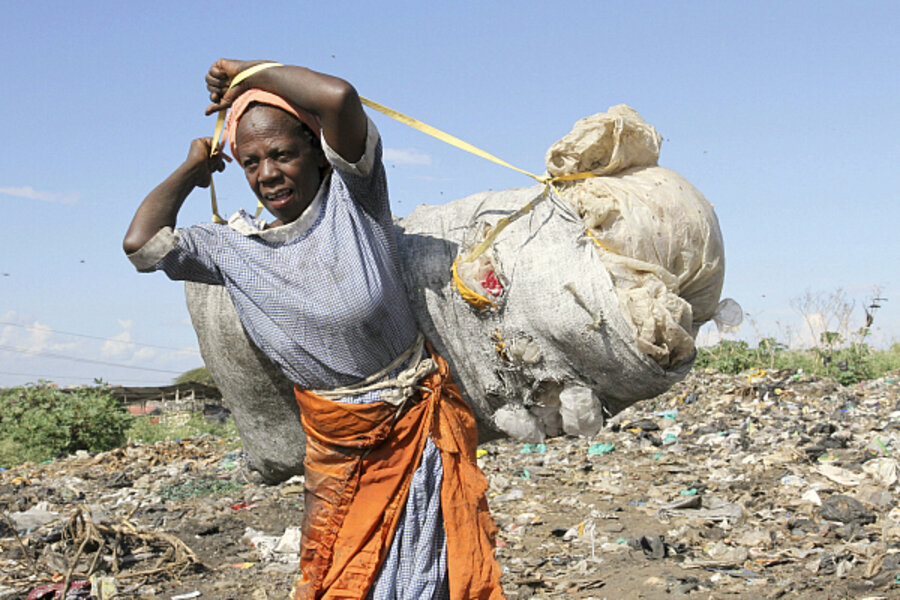Cut food waste to help feed the world, experts say
Loading...
| Nairobi, Kenya
Stick to what’s written on your shopping list. Check food expiration dates. Cook just enough but no more.
These and a few other simple practices can help curb global food waste, which amounts to 1.3 billion tons of food every year, experts say.
This is vital at a time when climate change and population growth are reducing the availability of food for millions of vulnerable people around the world, they add.
“With the World Bank warning of the possibility of a four-degrees-centigrade [7 degrees F.] temperature rise by the end of the decade and an expected world population of 9 billion by 2050, global food production and supply is going to be highly affected,” Dennis Garrity, United Nations drylands ambassador and senior fellow at the World Agroforestry Center told AlertNet in Nairobi. “The time to act is now.”
There are 870 million hungry people in the world today, experts estimate, but droughts, floods, storms, and climate-related plant diseases, among many other factors, continually reduce access to food.
Now experts say that cutting the amount of food that goes to waste, both in the developed and developing world, is key to addressing this.
One of Africa’s food waste hotspots is the Dandora rubbish dump on the outskirts of Nairobi.
The 30-acre piece of land receives 2,000 tons of solid waste every day, an uncertain share of it food waste. The presence of pigs, marabou storks, dogs, and other animals – as well as human scavengers – indicates there is plenty to eat, however.
“I have worked on this site for the past six years,” said Eunice Khasandi, a 36-year-old mother of four who scavenges waste food at the dump.
“We collect food and sell it to pig farmers on the outskirts of the city,” said Khasandi, who is one of an estimated 6,000 scavengers who visit the dump, according to the City Council of Nairobi.
The scavengers sell a 50-kilogram (110 lb.) sack of waste food for Sh200 ($2.50). If the sack contained an equivalent amount of maize meal, Kenya’s staple food, it would be enough to feed between 250 and 350 people if served with stew for lunch, nutrition experts say.
“Under normal circumstances, one kilogram (2.2 lbs.) of maize meal can feed between five and seven people,” explained Avraj Marwa, executive chef at the Sarova Panafric, a 4-star hotel in Nairobi.
Food ends up on rubbish dumps for a variety of reasons: because people buy on impulse, purchase items that are almost past their sell-by date, cook more than they can eat, or simply buy food that just never gets eaten.
The hospitality industry produces a great deal of food waste, Marwa said, trying to cater to different tastes among its clients. But many people also waste food through lack of education, he said, urging better education to limit that waste.
“We need to introduce eating etiquette lessons in African schools, at the earliest level. This can be of great benefit for the pupils, for society, and the future environment,” the chef said.
To mitigate the growing problem of food waste, the UN Environment Programme (UNEP) and the Food and Agriculture Organization (FAO) launched a global campaign in January. “Think. Eat. Save. Reduce Your Foodprint” aims to cut food waste worldwide.
This campaign comes two weeks after the launch of FoodTank, a food think tank initiative that aims to connect food producers, consumers, policymakers, activists, and farmers, with a view to reducing the amount of food that goes to waste.
“Wasting food makes no sense – economically, environmentally or ethically,” said Achim Steiner, UNEP’s executive director in a statement at the launch of the UNEP and FAO food waste campaign.
Kenya, like many other developing countries, also loses large amounts of food during post-harvesting handling, either to pests, poor storage, or contamination.
In 2011, for instance, 180 bags of maize weighing 90 kilograms (198 lbs.) each that were earmarked for relief were destroyed in Kituyi, eastern Kenya, in front of starving residents of Mutomo district, who had lost their crops to drought. The reason? The maize had been contaminated with aflatoxins.
Aflatoxins are naturally occurring toxic organisms that are produced by many species of fungus. They grow on grains, particularly maize and groundnuts, which have been stored with high moisture content. If eaten by humans, aflatoxins affect the liver and can cause death.
Paddy Likhayo, a grain storage expert from the Kenya Agricultural Research Institute, said grain losses to insects and other pests are also enormous in Kenya.
“We have also recorded huge grain losses due to pests,” Likhayo said in an interview with AlertNet. “Every season, pests destroy no less than 30 percent of the total grain harvested in the country.”
Millions of tons of food, particularly perishable fresh produce, also go to waste in the developing world as a result of poor transport networks or lack of markets, storage facilities, and processing equipment.
“I have witnessed people throwing away tomatoes, vegetables, and fruits, among other produce, simply because they did not find a market for it, and they have nowhere to keep it,” Jane Kathure Biashara, a Kenyan community development expert told AlertNet in a phone interview.
“If we can help food producers to reduce losses through better harvesting, processing, storage, transport, and marketing methods, and combine this with profound and lasting changes in the way people consume food, then we can have a healthier and hunger-free world,” said Graziano da Silva, the FAO director general, in a press statement.
• Isaiah Esipisu is a freelance journalist based in Nairobi, Kenya.
• This article originally appeared at AlertNet, a humanitarian news site operated by the Thomson Reuters Foundation.





